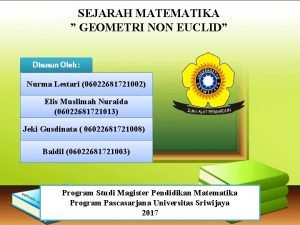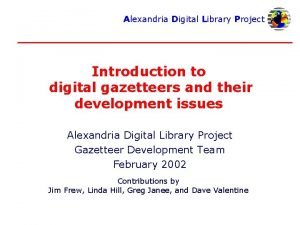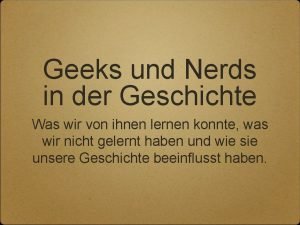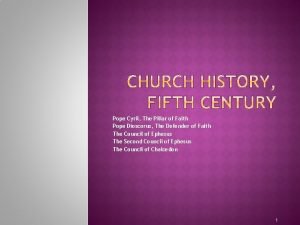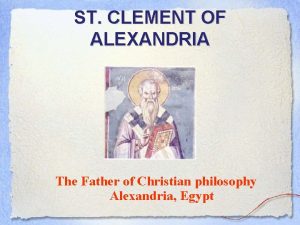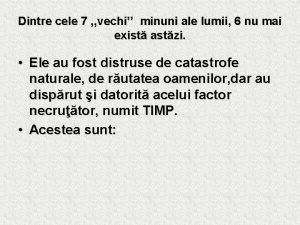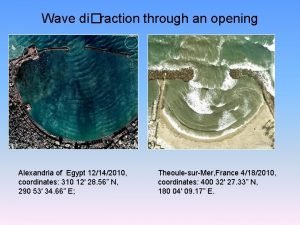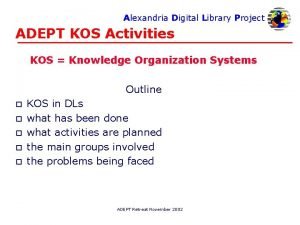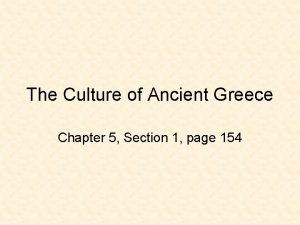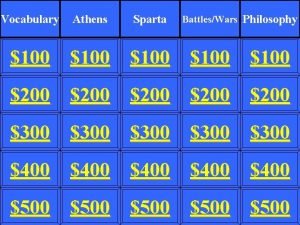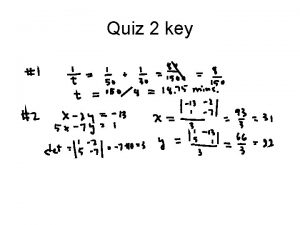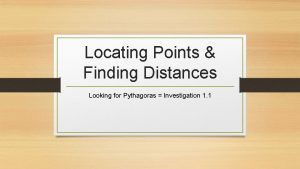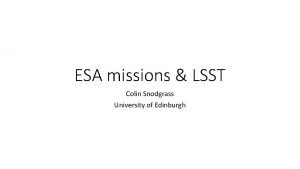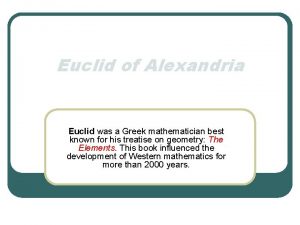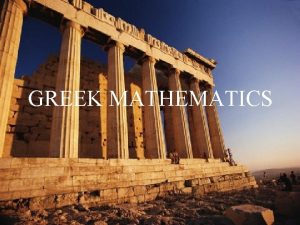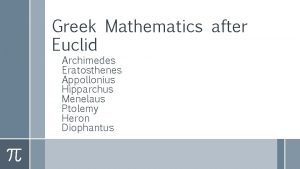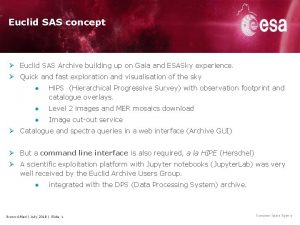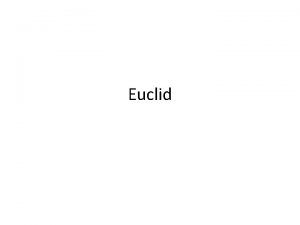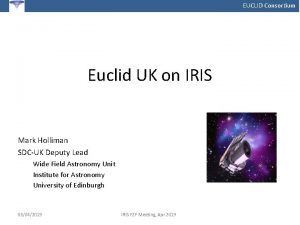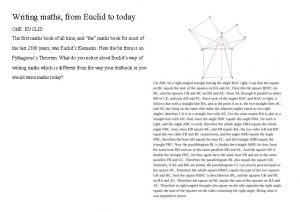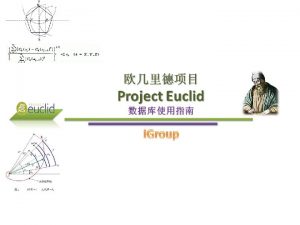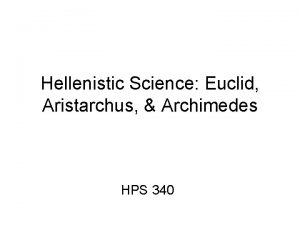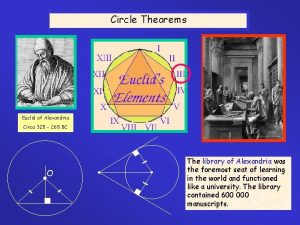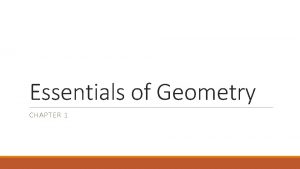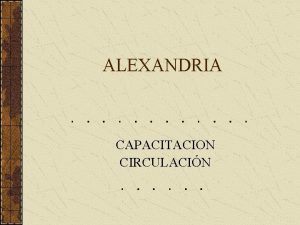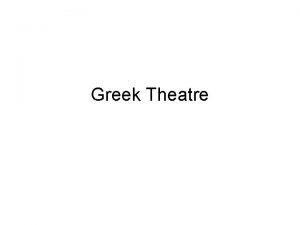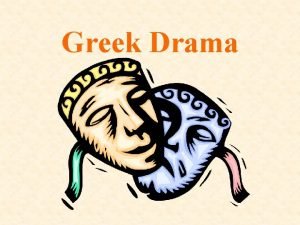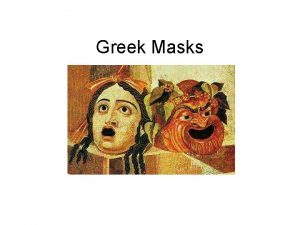EUCLID Greek Mathematics EUCLID OF ALEXANDRIA o Some

























- Slides: 25

EUCLID Greek Mathematics

EUCLID OF ALEXANDRIA o. Some say he is the leading teacher in mathematics o. There is a theory that many of his works were actually written by his team of mathematicians, just under his name (because we know so little about him) o. FATHER OF GEOMETRY

THE ELEMENTS o 13 books o. Proofs are not necessarily Euclid’s o. Most famous mathematical work of classical antiquity o. Logical development of Geometry, proportions, and number theory o. World’s oldest continuously used mathematical textbook o. Euclidean Geometry

THE ELEMENTS Compilation of works from famous mathematicians including: Pythagoras Hippocrates Theudius Theaetetus Eudoxus Contains 465 theorems and proofs al using only a compass and straight edge.


BOOK I – AXIOMS AND POSTULATES §Every Geometric Figure: Every line, every area, every volume can be constructed from just these postulates. §These postulates permit the use of a straight edge and compass “Euclidean Tools”

BOOK 1 -AXIOMS AND POSTULATES 1. Things that are equal to the same thing are equal to each other. 2. If equals are added to equals, the wholes are equal. 3. If equals are subtracted from equals, the remainders are equal. 4. Things that coincide with one another are equal to one another 5. The whole is greater than its parts.

BOOK 1 – AXIOMS AND POSTULATES 1. It is possible to draw a straight line from any point to any other point. 2. It is possible to extend a straight line indefinitely to a straight line. 3. It is possible to draw a line with any given radius. 4. All right angles are equal. 5. If a straight line intersects two other lines so that the angles on one side add to less

BOOK II Constructions of “basic” figures which have modern interpretations of algebraic identities. Sometimes referred to as “Euclid’s geometric Algebra” All theorems in this book are constructions

II. 4

BOOK III AND IV Circles without areas and circumferences

BOOK V-EUDOXUS’ PROPORTION “Magnitudes are said to be in the same ratio, the first to the second and the third to the fourth when, if any equimultiples whatever be taken of the first and third, and any equimultiples whatever of the second and fourth, the former equimultiples alike exceed, are alike equal to, or alike fall short of, the latter equimultiples respectively taken in corresponding order”

BOOK VI Book 6 application of Book 5 VI. 1 Triangles and parallelograms which have the same altitude are in the same proportion as their bases. VI. 33 In equal circles, angles have the same ratio to the whole as their arcs have to the circumference on which they stand, whether the angle be at the center or on the circumference

BOOKS VII - IX NUMBER THEORY AND COMMENSURABILITY Definition: A unit is that by which each of the other things exist is called one Definition: A number is a multitude of composed units Definition: A prime number is a number that is measured by a unit alone

THE EUCLIDEAN ALGORITHM (VII. 3) This is an algorithm for calculating the greatest common denominator Based on the fact that the GCD of two numbers does not change if the larger number is replaced by its difference with the smaller number For Example: 21 is the GCD of 252 and 105. 21 is also the GCD of 105 and 147 = 252 -105 You can also replace with the divisor of the two numbers, which is much more efficient

BOOKS XI, XIII Solid Geometry and the hard proofs that use Eudoxian Proportion -Theon of Alexandria made the most changes in these books

BOOKS XI, XIII Book XI is solid geometry without proportions Book XII applies Eudoxian proportion with both areas and volumes

BOOK XIII 5 Euclidean Solids: Cube, Tetrahedron, Octahedron, Icosahedron, and Dodecahedron

M. I. A

M. I. A Books VII-IX contain an entire proof that numbers factor uniquely into prime numbers, but never actually creates a proposition for that

CHALLENGE ACCEPTED There were 3 problems that Greek Geometers identified in Euclid’s Elements: q. Duplicate the Cube q. Trisect the Angle q. Square the Circle

TRISECT THE ANGLE v. Given any angle, construct an angle so that the original is exactly three times the size of the constructed angle. v. The Greeks had drafting tools that could do this approximately, they assumed. Euclid just said that we don’t need them.

SQUARE THE CIRCLE

EUCLID’S OTHER WORKS Found: Data (a different or earlier account of Elements I-IV) Phaenonomena (An account of Spherical Geometry applied to Astronomy) Optics (The branch of Physics best suited to Greek Geometrical Methods) Lost: Conics (probably made obsolete by later work) Porisms (higher level geometry beyond the Elements) Psuedaria (A book of Logic)

REFERENCES http: //farside. ph. utexas. edu/Books/Euclid/Elements. pdf https: //en. wikipedia. org/wiki/Euclidean_algorithm University of Arizona History of Mathematics http: //www-history. mcs. st-and. ac. uk/Biographies/Euclid. html http: //www. storyofmathematics. com/hellenistic_euclid. html
 Geometri eliptik
Geometri eliptik Pope demetrius i of alexandria
Pope demetrius i of alexandria Alexandria digital library
Alexandria digital library Ken wiggled his foot
Ken wiggled his foot Heron von alexandria geboren
Heron von alexandria geboren Pope dioscorus i of alexandria
Pope dioscorus i of alexandria Alexandria crystal peak
Alexandria crystal peak Clement of alexandria paedagogus
Clement of alexandria paedagogus Alexandria vattimo
Alexandria vattimo Farul din alexandria aflat pe o insulă mică numită
Farul din alexandria aflat pe o insulă mică numită Nermin hannay
Nermin hannay Wave alexandria
Wave alexandria Alexandria kos
Alexandria kos Apa serv alexandria
Apa serv alexandria Why did the city of alexandria attract scholars
Why did the city of alexandria attract scholars Die acht weltwunder
Die acht weltwunder Alexandria digital library
Alexandria digital library Minnie howard field
Minnie howard field The ancient library of alexandria
The ancient library of alexandria Alexandria phan md
Alexandria phan md Clemens ad tabernam quam quintus
Clemens ad tabernam quam quintus Pythagoras and euclid were outstanding hellenistic
Pythagoras and euclid were outstanding hellenistic Aecsd
Aecsd Euclid algorithm formula
Euclid algorithm formula Looking for pythagoras
Looking for pythagoras Colin snodgrass
Colin snodgrass
